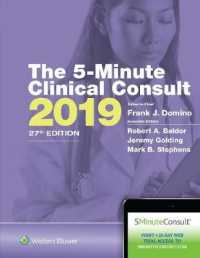Full Description
This book analyses the vulnerability of adolescent girls, which results from cumulative inequalities: gender, lack of education, residential, and poverty. It is based on original analyses of data from the national survey carried out by the National Institute of Statistics and Economic Analysis in collaboration with UNICEF.
The book discusses three main themes. First, the experience of adolescence: access to globalization, via access to TIC (Trusted Internet Connections) and mass media; subjective well-being; smoking and alcohol consumption; child discipline and domestic violence are discussed. Secondly, the book focusses on the beginning of fertile life: child marriage; early pregnancy; prenatal care; birth weight and breastfeeding. HIV/AIDS and sexuality.
The third theme touches on the potential contribution of adolescents to harvesting the demographic dividend: fertility and contraception; postnatal care and vaccination of children; pre-school learning; education andgender; household health vulnerability (water and sanitation). On the basis of the analyses of data, implications regarding concrete policy measures aimed at reducing the vulnerability of adolescents are identified at the end of each chapter.
Through the richness of the analyses and the methodological rigor, this book provides an interesting read to both specialists and non-specialists interested in adolescence and the future of Benin, Africa and beyond.
The [basis of the] English translation of this book from its French original manuscript was done with the help of artificial intelligence. A subsequent human revision of the content was done by the author.
Contents
Foreword.- Chapter 1: Introduction.- Part I: The Experience of Adolescence in Benin.- Chapter 2: Access to Mass Media and Use of Information and Communication Technologies.- Chapter 3: The Well-Being of Adolescents.- Chapter 4: Hiv/Aids and Sexual Behaviour.- Chapter 5: Tobacco and Alcohol Use.- Chapter 6: Attitudes on Child Discipline and Domestic Violence.- Chapter 7: The Work of Adolescents.- Part Ii: Child Marriage and Early Pregnancy: Chapter 8: Child Marriage and Polygamy.- Chapter 9: Early Pregnancy and Prenatal Care of Adolescent Mothers.- Chapter 10: Birth Weight and Breastfeeding of The Child.- Part Iii: Socio-Demographic Conditions of the Dividend in Benin: Chapter 11: Adolescents' Fertility and Dividend.- Chapter 12: Contraception and Demographic Dividend.- Chapter 13: Postnatal Care and Immunization of Children.- Chapter 14: Preparing for the Future of Early Childhood.- Chapter 15: Education, Gender and Demographic Dividend.- Chapter 16: Household Health Vulnerability:Water and Sanitation.- List of Tables and Charts.- Appendix: The Mics 2014 Survey.







